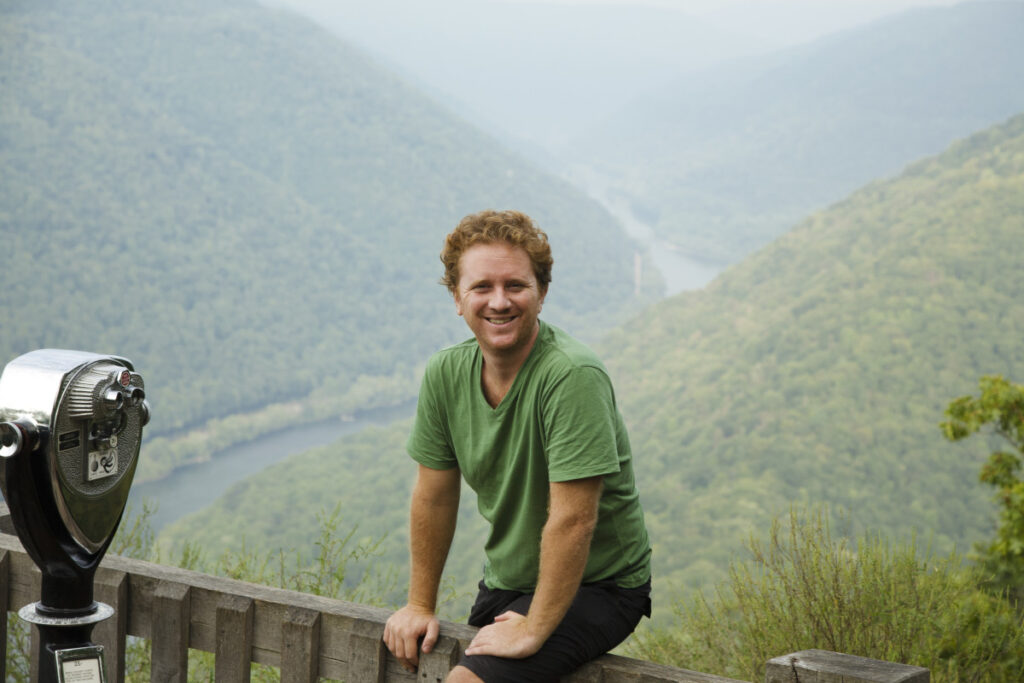In December 2020, the New River Gorge National Park and Preserve near Fayetteville, West Virginia became America’s newest national park.
Established by the U.S. Congress and maintained by the National Park Service, the nation’s 63 national parks are protected areas with national significance, representing diverse ecosystems with exceptional natural beauty.
They have been set aside for everyone to enjoy, and they are subject to different rules and regulations than other types of public land.
National parks encompass all types of terrain, including mountains, valleys, deserts, wilderness — even volcanoes. And while you may already be familiar with some of the country’s most popular national parks (like the Grand Canyon, Yosemite, and the Great Smoky Mountains), the five newest national parks, established between 2013 and 2020, are just as spectacular — and definitely worth a visit.
Related: 6 national parks outside the U.S. to add to your bucket list
Tetra images; Getty Images
What are the 5 newest national parks?
The country’s newest national parks stretch from sea to shining sea. Here they are from most recent to least:
1. New River Gorge National Park
- State: West Virginia
- Established: December 27, 2020
- Best time to visit: Fall
Known for its deep canyons and rugged, whitewater river, America’s newest national park — New River Gorge — is easily reachable from Interstates I-64 and I-79 and encompasses 70,000 acres of wooded, mountainous terrain and waterfalls.
Trails wind through old mining towns that tell the story of Appalachia. Visitors can enjoy a variety of activities including hiking, rock climbing, mountain biking, world-class whitewater rafting, and tubing down the New River.
Home to white-tailed deer, black bears, snakes, turtles, salamanders, bald eagles, and peregrine falcons, the park gets quite crowded in the summer, but it experiences a more leisurely pace in the autumn, when the changing leaves create stunning landscapes.
Don’t miss the park’s most iconic landmark — a mile-long steel arch bridge that spans the New River; it’s the longest in the western hemisphere and is viewable from the Canyon Rim Visitors’ Center — there’s even a wheelchair-accessible viewing deck that, on clear days, affords a glimpse deep into the gorge.
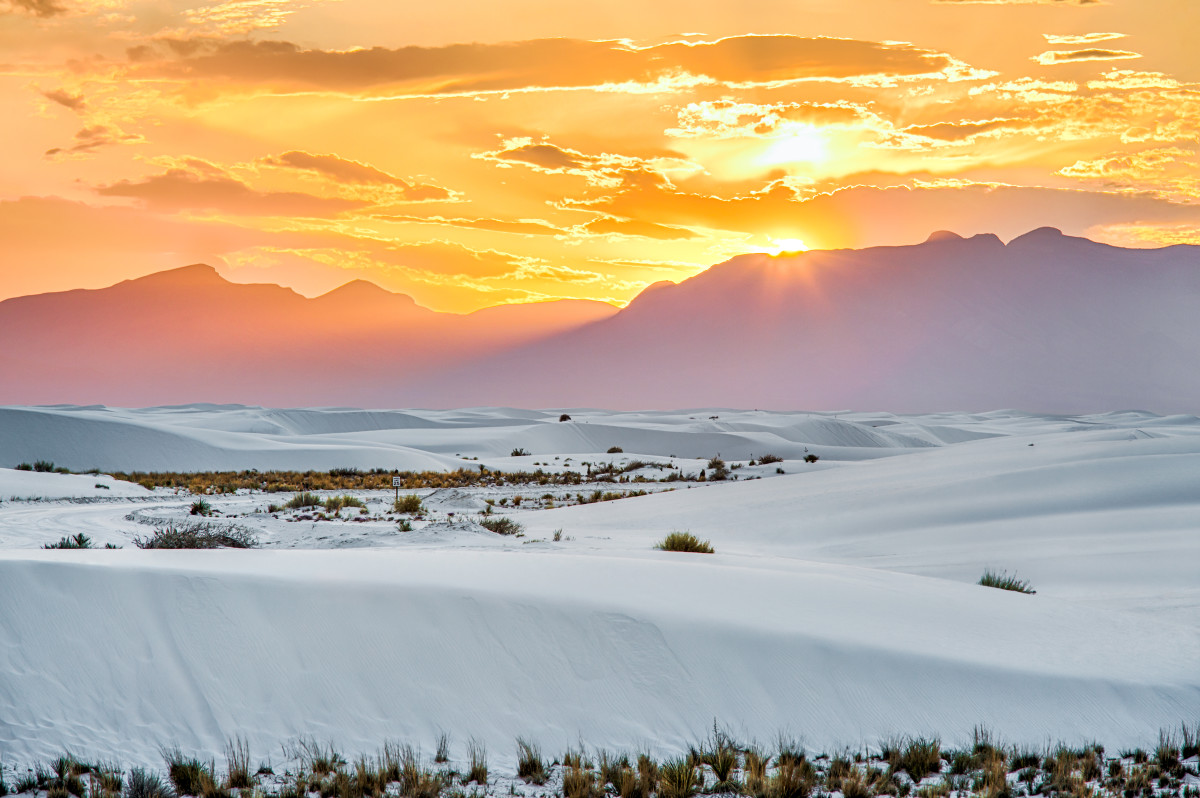
Peter Unger; Getty Images
2. White Sands National Park
- State: New Mexico
- Established: December 20, 2019
- Best time to visit: Spring or fall
Located in the Tularosa Basin of southern New Mexico, White Sands‘ otherworldly landscape positively shimmers with each gust of wind, as nearly three hundred square miles of white gypsum dunes shape-shift to spectacular effect. The best time to visit the area is at sunrise or sunset when the dunes take on bold red and orange hues.
Even in this harsh environment, you’ll find that life abounds — if you know where to find it. The park is home to jackrabbits, bobcats, frogs, salamanders, rattlesnakes, lizards, and box turtles, even white animal species that have evolved to blend in with the desert.
Visitors can explore the stark landscape themselves on foot, through a ranger-led hike, or even by backcountry camping. The park extends its hours during full moons in the summer and offers free live music and artistic performances in its amphitheater.
But perhaps the coolest way to experience the dunes is to sled down them: You can pack your own sled, or for around $25 (or $15 used), you can purchase a plastic saucer at the visitor center.
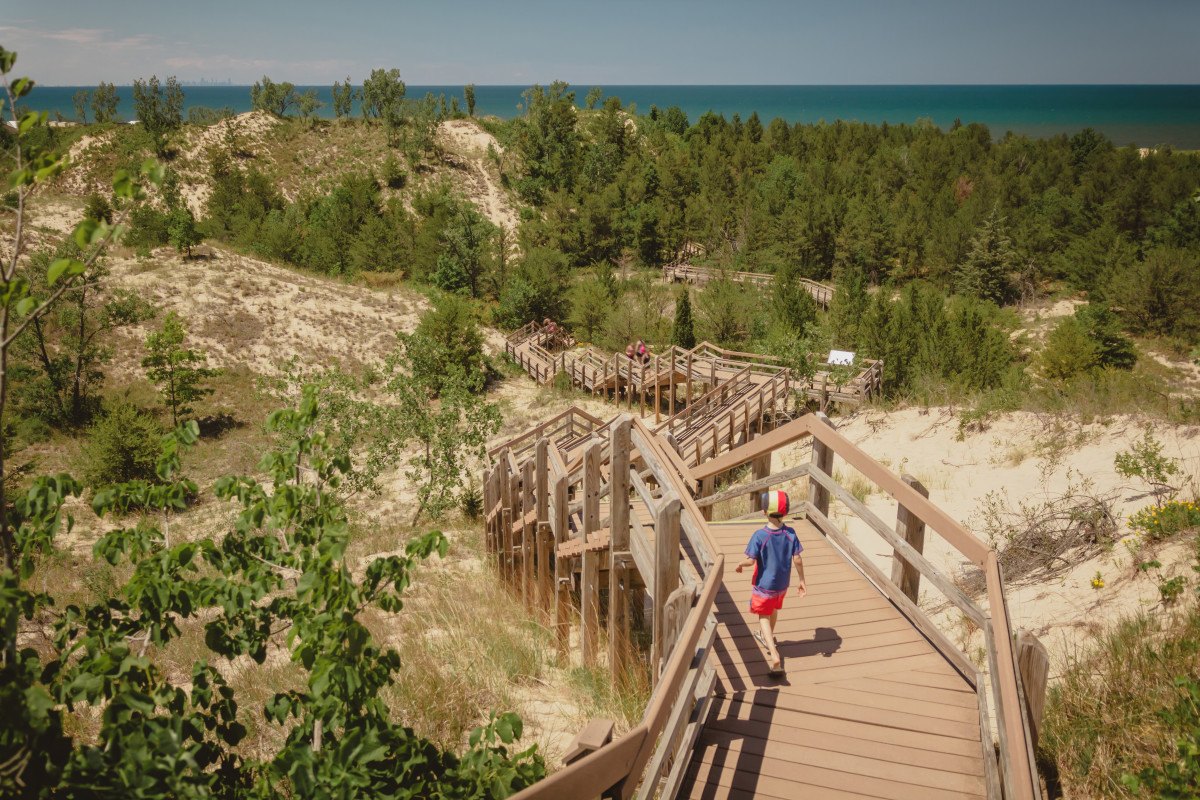
Jon Lauriat; Getty Images
3. Indiana Dunes National Park
- State: Indiana
- Established: February 15, 2019
- Best time to visit: Spring or fall
Less than an hour’s drive from Chicago, Indiana Dunes is located on the southern shores of Lake Michigan, one of the largest freshwater lakes in the world.
More suburban than other wilderness areas, Indiana Dunes features 15 miles of coastline and 50 miles of trails that traverse a range of habitats including woodlands, wetlands, and wildflower-filled prairies.
Spring and fall are the best times to visit to avoid the throngs of people — over two million visitors enjoy this park each year, rivaling it in popularity to Yosemite.
Activities include hiking, camping, cross-country skiing, horseback riding, swimming, and fishing on the lake or along the Calumet River, but the park is best known for its birdwatching opportunities, as the area is an important resting spot for more than 350 species of migratory fowl.

Ron and Patty Thomas; Getty Images
4. Gateway Arch National Park
- State: Missouri
- Established: February 22, 2018
- Best time to visit: Winter
Next to the Mississippi River in the heart of St. Louis, Gateway Arch is a 91-acre urban park that features the iconic Gateway Arch (the park’s namesake), which was designed by Eero Saarinen in 1965 to symbolize the “Gateway to the West.”
The grounds also encompass the Old Courthouse, where pivotal Dred Scott slavery trials took place before the Civil War, and a museum with exhibits detailing the history of American westward expansion. For a unique perspective of the famous Arch, you can hop aboard a riverboat cruise, which also departs from the park.
But the park’s most popular attraction is the Arch itself — visitors can even go to the top of the 630-foot Arch via a 4-minute tram ride ($15 for adults). The topside viewing area offers panoramic vistas of downtown and the Mississippi River.
Winter is the best time to visit, as the weather is mild and there’s usually little to no wait to take the tram to the top of the arch.
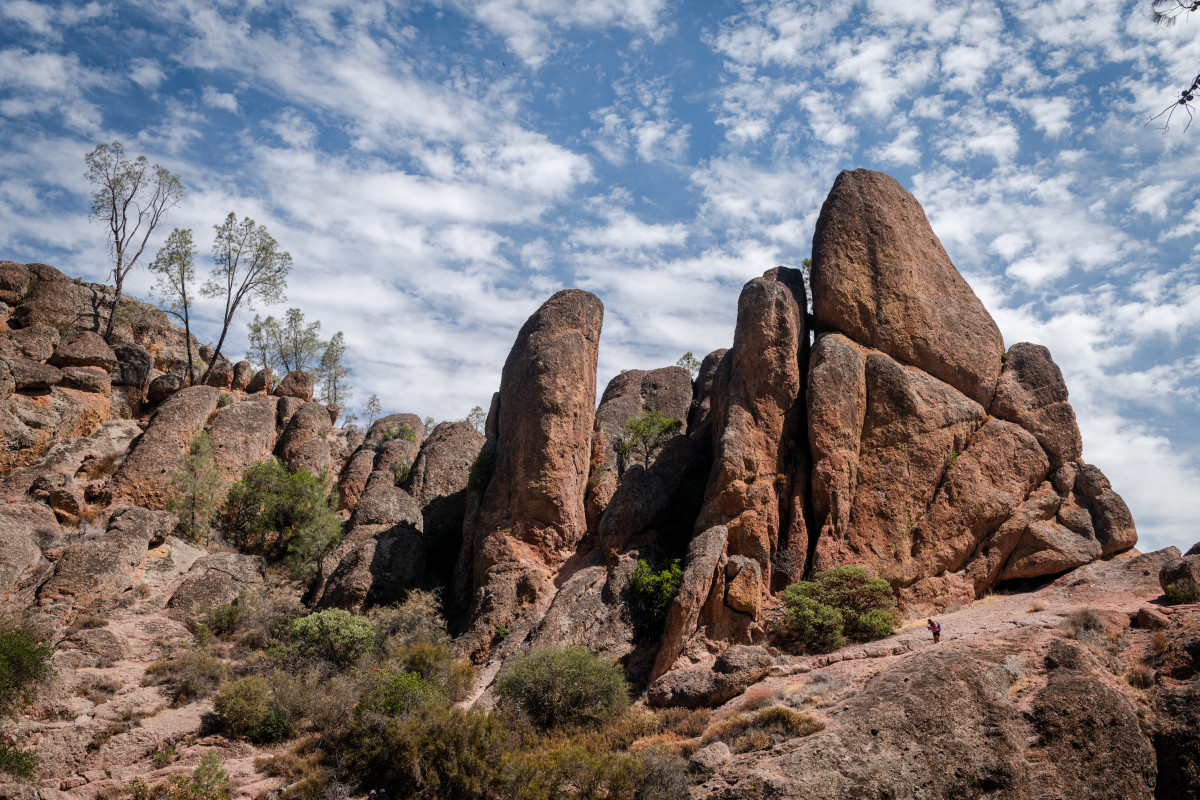
Yiming Chen, Getty Images
5. Pinnacles National Park
- State: California
- Established: January 10, 2013
- Best time to visit: Anytime but summer
Less than 100 miles from San Francisco and due west of the San Andreas Fault, the land that makes up Pinnacles NP was formed from the remnants of ancient volcanoes millions of years ago and continues to be shaped by tectonic forces.
Within this landscape of chaparral and canyons, visitors can explore striking geological wonders including rock formations and hidden caves. Camping, hiking, and rock climbing terrain are especially popular, as well as stargazing amongst its exceptionally clear skies.
Birdwatchers won’t want to miss the Condor Gulch Trail, where 200 species of birds can be seen soaring above the cliffs, from condors to prairie falcons, swallows, and even golden eagles.
With the extreme summertime heat — temperatures routinely exceed 100 degrees Fahrenheit in the summer in July and August — visiting the park during the fall, winter, or spring months is recommended.
More on national parks:
- Woman is first to get injured from this at national park in 2024
- Six national parks make change travelers are sure to like
- National park finally lifts restrictions introduced in July
A brief history of America’s national parks
The National Park Service was formed by the Organic Act of 1916, although the country’s first national park, Yellowstone, was established nearly half a century before that, in 1872.
Through writing, painting, and photography, preservationists like John Muir, Nathaniel P. Langford, and Thomas Moran, among others, raised public awareness of these breathtaking areas in order to protect them from being developed in the 19th century. Between 1901 and 1909, President Theodore Roosevelt set aside 230 million acres of public lands that would later be designated as national parks, including:
- Crater Lake National Park in Oregon
- Wind Cave National Park in South Dakota
- Mesa Verde National Park in Colorado
In 1983, writer Wallace Stegner called the concept of the National Parks “America’s best idea” because they were inclusive spaces that unified people from all walks of life — something everyone could be proud of.
“National parks are the best idea we ever had. Absolutely American, absolutely democratic, they reflect us at our best rather than our worst.”
—Wallace Stegner, 1983
Related: People don’t come to this national park (here is why)
A map of the United States’ national parks
Here’s a comprehensive look at America’s national parks:
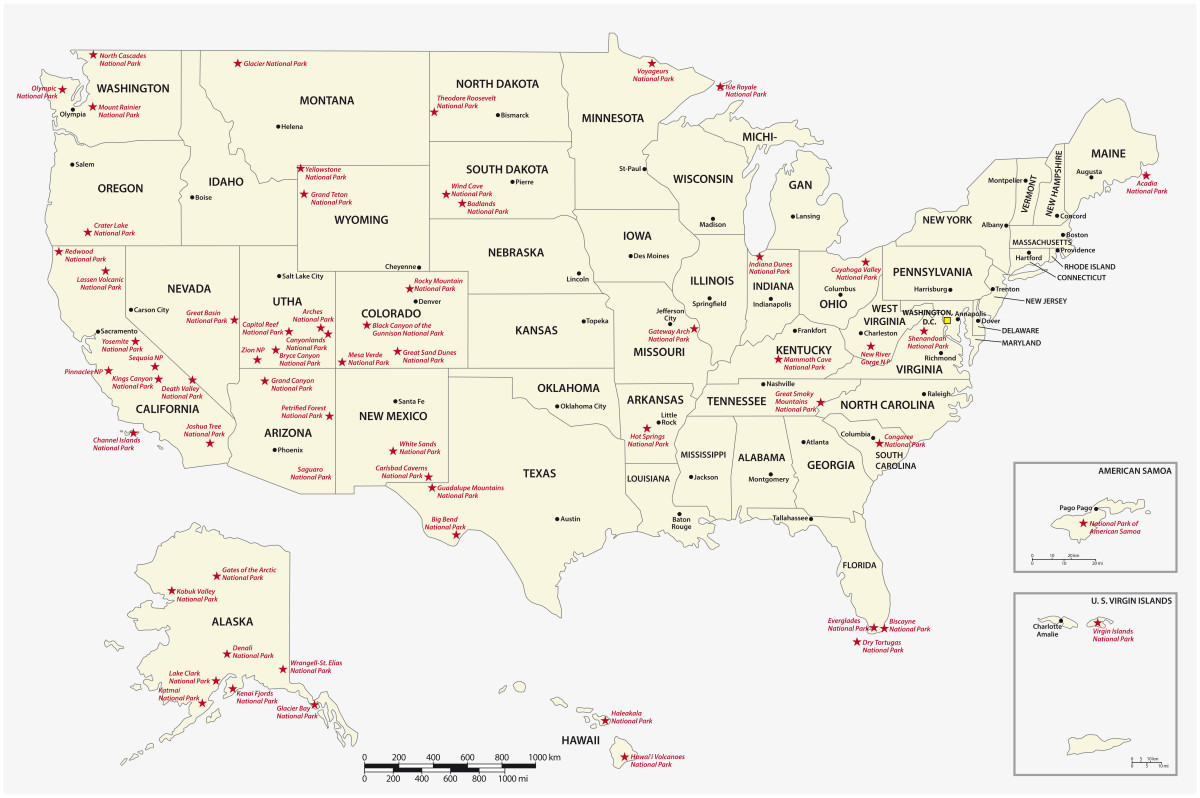
Rainer Lesniewski; Getty Images
List of America’s national parks by state
Thirty states and two U.S. territories have National Parks. California is the state with the most national parks — nine.
Alaska
- Denali, Alaska
- Gates of the Arctic, Alaska
- Glacier Bay, Alaska
- Katmai, Alaska
- Kenai Fjords, Alaska
- Kobuk Valley, Alaska
- Lake Clark, Alaska
- Wrangell-St. Elias, Alaska
American Samoa
- National Park of American Samoa, American Samoa
Arizona
- Grand Canyon, Arizona
- Petrified Forest, Arizona
- Saguaro, Arizona
Arkansas
- Hot Springs, Arkansas
California
- Channel Islands, California
- Death Valley, California and Nevada
- Joshua Tree, California
- Kings Canyon, California
- Lassen Volcanic, California
- Pinnacles, California
- Redwood, California
- Sequoia, California
- Yosemite, California
Colorado
- Black Canyon of the Gunnison, Colorado
- Great Sand Dunes, Colorado
- Mesa Verde, Colorado
- Rocky Mountain, Colorado
Florida
- Biscayne, Florida
- Dry Tortugas, Florida
- Everglades, Florida
Hawaii
- Haleakala, Hawaii
- |Hawai’i Volcanoes, Hawaii
Idaho
- Yellowstone, Idaho, Montana, and Wyoming
Kentucky
- Mammoth Cave, Kentucky
Indiana
- Indiana Dunes
Maine
- Acadia, Maine
Michigan
- Isle Royale, Michigan
Minnesota
- Voyageurs, Minnesota
Missouri
- Gateway Arch, Missouri
Montana
- Glacier, Montana
- Yellowstone, Idaho, Montana, and Wyoming
Nevada
- Death Valley, California and Nevada
- Great Basin, Nevada
New Mexico
- Carlsbad Caverns, New Mexico
- White Sands, New Mexico
North Dakota
- Theodore Roosevelt, North Dakota
North Carolina
- Great Smoky Mountains, North Carolina and Tennessee
Ohio
- Cuyahoga Valley, Ohio
Oregon
- Crater Lake, Oregon
South Carolina
- Congaree, South Carolina
South Dakota
- Badlands, South Dakota
- Wind Cave, South Dakota
Tennessee
- Great Smoky Mountains, North Carolina and Tennessee
Texas
- Big Bend, Texas
- Guadalupe Mountains, Texas
Utah
- Arches, Utah
- Bryce Canyon, Utah
- Canyonlands, Utah
- Capitol Reef, Utah
- Zion, Utah
Virgin Islands
- Virgin Islands, Virgin Islands
Virginia
- Shenandoah, Virginia
Washington
- Mount Rainier, Washington
- North Cascades, Washington
- Olympic, Washington
West Virginia
- New River Gorge, West Virginia
Wyoming
- Grand Teton, Wyoming
- Yellowstone
Related: Veteran fund manager sees world of pain coming for stocks
